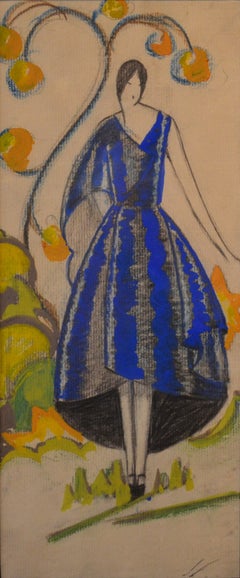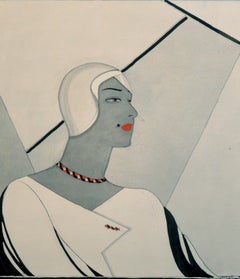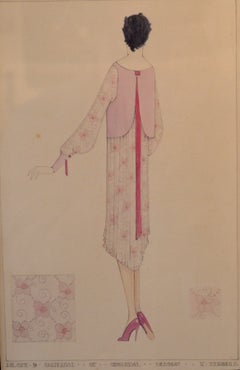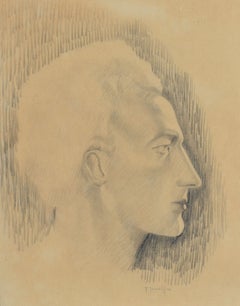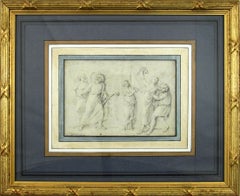Art Deco Drawings and Watercolor Paintings
to
6
6
6
Overall Height
to
Overall Width
to
6
6
5
2
2
2
1
1
1
1
1
1
1
6
6
7
31
16
13
9
5
4
1
1
1
Style: Art Deco
Artist: Thelma Terrell
Springtime
Located in West Hollywood, CA
Our Gallery acquired the estate of a Northern California artist, Thelma Terrell. Terrell lived in Oakland and was an illustrator and professional graphic artist.
"Springtime" is an ...
Category
1930s Art Deco Drawings and Watercolor Paintings
Materials
Mixed Media, Paper
Femmes Fatal
Located in West Hollywood, CA
Our Gallery acquired the estate of a Northern California artist, Thelma Terrell. Terrell lived in Oakland and was an illustrator and professional graphic artist.
"Femmes Fatal" is a...
Category
1930s Art Deco Drawings and Watercolor Paintings
Materials
Watercolor
Deco Femme
Located in West Hollywood, CA
Our Gallery acquired the estate of a Northern California artist, Thelma Terrell. Terrell lived in Oakland and was an illustrator and professional graphic artist.
"Deco Femme" is an ...
Category
1930s Art Deco Drawings and Watercolor Paintings
Materials
Mixed Media, Paper
Dandy
Located in West Hollywood, CA
Our Gallery acquired the estate of a Northern California artist, Thelma Terrell. Terrell lived in Oakland and was an illustrator and professional graphic artist.
"Dandy" is an origi...
Category
1930s Art Deco Drawings and Watercolor Paintings
Materials
Mixed Media, Paper
The Pink Dress
Located in West Hollywood, CA
Our Gallery acquired the estate of a Northern California artist, Thelma Terrell. Terrell lived in Oakland and was an illustrator and professional graphic artist.
"The Pink Dress...
Category
1930s Art Deco Drawings and Watercolor Paintings
Materials
Mixed Media, Paper
Male Portrait
Located in West Hollywood, CA
A number of years ago, we acquired the balance of a Northern California estate of artist Thelma Terrell. Terrell lived in Oakland and was an illustator and commercial graphic artist.
This male...
Category
1930s Art Deco Drawings and Watercolor Paintings
Materials
Paper, Pencil
Related Items
The Abduction of the Sabine Women , a Renaissance drawing by Biagio Pupini
Located in PARIS, FR
This vigorous drawing has long been attributed to Polidoro da Caravaggio: The Abduction of the Sabine Women is one of the scenes that Polidoro depicted between 1525 and 1527 on the façade of the Milesi Palazzo in Rome. However, the proximity to another drawing inspired by this same façade, kept at the Ecole des Beaux-Arts, and to other drawings inspired by Polidoro kept at the Musée du Louvre, leads us to propose an attribution to Biagio Pupini, a Bolognese artist whose life remains barely known, despite the abundant number of drawings attributed to him.
1. Biagio Pupini, a Bolognese artist in the light of the Roman Renaissance
The early life of Biagio Pupini, an important figure of the first half of the Cinquecento in Bologna - Vasari mentions him several times - is still poorly known. Neither his date of birth (probably around 1490-1495) nor his training are known. He is said to have been a pupil of Francesco Francia (1450 - 1517) and his name appears for the first time in 1511 in a contract with the painter Bagnacavallo (c. 1484 - 1542) for the frescoes of a church in Faenza. He then collaborated with Girolamo da Carpi, at San Michele in Bosco and at the villa of Belriguardo.
He must have gone to Rome for the first time with Bagnacavallo between 1511 and 1519. There he discovered the art of Raphael, with whom he might have worked, and that of Polidoro da Caravaggio. This first visit, and those that followed, were the occasion for an intense study of ancient and modern art, as illustrated by his abundant graphic production.
Polidoro da Caravaggio had a particular influence on the technique adopted by Pupini. Executed on coloured paper, his drawings generally combine pen, brown ink and wash with abundant highlights of white gouache, as in the drawing presented here.
2. The Abduction of the Sabine Women
Our drawing is an adaptation of a fresco painted between 1525 and 1527 by Polidoro da Caravaggio on the façade of the Milesi Palace in Rome. These painted façades were very famous from the moment they were painted and inspired many artists during their stay in Rome. These frescoes are now very deteriorated and difficult to see, as the palace is in a rather narrow street.
The episode of the abduction of the Sabine women (which appears in the centre of the photo above) is a historical theme that goes back to the origins of Rome and is recounted both by Titus Livius (Ab Urbe condita I,13), by Ovid (Fasti III, 199-228) and by Plutarch (II, Romulus 14-19). After killing his twin brother Romus, Romulus populates the city of Rome by opening it up to refugees and brigands and finds himself with an excess of men. Because of their reputation, none of the inhabitants of the neighbouring cities want to give them their daughters in marriage. The Romans then decide to invite their Sabine neighbours to a great feast during which they slaughter the Sabines and kidnap their daughters.
The engraving made by Giovanni Battista Gallestruzzi (1618 - 1677) around 1656-1658 gives us a good understanding of the Polidoro fresco, allowing us to see how Biagio Pupini reworked the scene to extract this dynamic group.
With a remarkable economy of means, Biagio Pupini takes over the left-hand side of the fresco and depicts in a very dense space two main groups, each consisting of a Roman and a Sabine, completed by a group of three soldiers in the background (which seems to differ quite significantly from Polidoro's composition).
The balance of the drawing is based on a very strongly structured composition. The drawing is organised around a median vertical axis, which runs along both the elbow of the kidnapped Sabine on the left and the foot of her captor, and the two main diagonals, reinforced by four secondary diagonals. This diamond-shaped structure creates an extremely dynamic space, in which centripetal movements (the legs of the Sabine on the right, the arm of the soldier on the back at the top right) and centrifugal movements (the arm of the kidnapper on the left and the legs of the Sabine he is carrying away, the arm of the Sabine on the right) oppose each other, giving the drawing the appearance of a whirlpool around a central point of support situated slightly to the left of the navel of the kidnapper on the right.
3. Polidoro da Caravaggio, and the decorations of Roman palaces
Polidoro da Caravaggio was a paradoxical artist who entered Raphael's (1483 - 1520) workshop at a very young age, when he oversaw the Lodges in the Vatican. Most of his Roman work, which was the peak of his career, has disappeared, as he specialised in facade painting, and yet these paintings, which are eminently visible in urban spaces, have influenced generations of artists who copied them abundantly during their visits to Rome.
Polidoro Caldara was born in Caravaggio around 1495-1500 (the birthplace of Michelangelo Merisi, known as Caravaggio, who was born there in 1571), some forty kilometres east of Milan. According to Vasari, he arrived as a mason on the Vatican's construction site and joined Raphael's workshop around 1517 (at the age of eighteen according to Vasari). This integration would have allowed Polidoro to work not only on the frescoes of the Lodges, but also on some of the frescoes of the Chambers, as well as on the flat of Cardinal Bibiena in the Vatican.
After Raphael's death in 1520, Polidoro worked first with Perin del Vaga before joining forces with Maturino of Florence (1490 - 1528), whom he had also known in Raphael's workshop. Together they specialised in the painting of palace façades. They were to produce some forty façades decorated with grisaille paintings imitating antique bas-reliefs.
The Sack of Rome in 1527, during which his friend Maturino was killed, led Polidoro to flee first to Naples (where he had already stayed in 1523), then to Messina. It was while he was preparing his return to the peninsula that he was murdered by one of his assistants, Tonno Calabrese, in 1543.
In his Vite, Vasari celebrated Polidoro as the greatest façade decorator of his time, noting that "there is no flat, palace, garden or villa in Rome that does not contain a work by Polidoro". Polidoro's facade decorations, most of which have disappeared as they were displayed in the open air, constitute the most important lost chapter of Roman art of the Cinquecento. The few surviving drawings of the painter can, however, give an idea of the original appearance of his murals and show that he was an artist of remarkable and highly original genius.
4. The façade of the Milesi Palace
Giovanni Antonio Milesi, who commissioned this palace, located not far from the Tiber, north of Piazza Navona, was a native of the Bergamo area, like Polidoro, with whom he maintained close friendly ties. Executed in the last years before the Sack of Rome, around 1526-1527, the decoration of Palazzo Milesi is considered Polidoro's greatest decorative success.
An engraving by Ernesto Maccari made at the end of the nineteenth century allows us to understand the general balance of this façade, which was still well preserved at the time. The frescoes were not entirely monochrome, but alternated elements in chiaroscuro simulating marble bas-reliefs and those in ochre simulating bronze and gold vases...
Category
16th Century Art Deco Drawings and Watercolor Paintings
Materials
Ink, Gouache, Pen
François-Édouard Picot (French 1786-1868) Greek Comedy Play 19th Century Drawing
By François-Édouard Picot
Located in Meinisberg, CH
François-Édouard Picot
(French, 1786 – 1868)
Ancient Greek Comedy Play
• Pencil Drawing on laid paper behind decorative matting, visible image, ca. 10.5 x 15.5 cm
• Modern Glased frame, ca. 27 x 33 cm
• Signed "Picot fecit" lower left
• As we photographed through glass, there are reflections in the images
Worldwide shipping is complimentary - There are no charges for handling & delivery
Here we have the somewhat unusual, yet typical subject matter François-Édouard Picot was interested in depicting. Shown is a scene from an ancient Greek comedy play. The previous owner has noted on the back, that this image was copied from an ancient Greek stone relief.
François-Édouard Picot was born on the 10th of October in 1786 in Paris, France. He studied with various masters and became well known for his historical and mythological subjects. In 1812 he won the second prize in the Prix de Rome competition and after that success, went on to exhibit at the Paris Salon, where in the year 1819 he won a first-class medal for his neoclassical L'Amour et Psyché, which today hangs in the Louvre in Paris. He regularly exhibited his work in the salon up to 1839. He taught several young great artists at his elitist studio and was known for accepting only very few students, which included William Bouguereau, Gustave Moreau, Cabanel and Paul Seignac...
Category
Early 19th Century Art Deco Drawings and Watercolor Paintings
Materials
Laid Paper, Pencil
Free Shipping
H 10.63 in W 13 in D 1.19 in
Costume drawings for ‘Ambassadeur de Siam’ and ‘La Sultana Reine’
Located in Amsterdam, NL
Joseph-Marie Vien (1716-1809)
‘Ambassadeur de Siam’ and ‘La Sultana Reine’
Both titled lower centre, the drawing of the ambassador inscribed with colours intended for the prints, e...
Category
Mid-18th Century Art Deco Drawings and Watercolor Paintings
Materials
Paper, Pencil
Free Shipping
H 9.26 in W 6.89 in D 1.19 in
François-Maurice Roganeau (1883-1973) Portrait of young man 1947, watercolor
Located in Paris, FR
François-Maurice Roganeau (1883-1973)
Portrait of a young man, 1947
signed and dated lower left
Titled Guy Ernoult (name of the sitter) on the upper part
27 x 22 cm
in a beautiful f...
Category
1940s Art Deco Drawings and Watercolor Paintings
Materials
Watercolor, Pencil
Art Deco Costume Design - Eva
Located in Miami, FL
The paper in some of these photos looks overly textured due to the sharpness of the high-res digital camera.
In person, with the human eye, the paper looks reasonably smooth with out blemishes.
For this fashion illustration, Georges Lepape paints a stunning abstract pattern for the subject dress that is repeated in her hair. The work represents an early use of metallic paint, with silver metallic in the dress and bronze metallic in the blouse. Lepape's highly detailed drawing becomes more evident the closer you look. It's quite amazing how deftly he rendered facial feature on such a small scale. "Eva" 1918 Gouache, watercolor, and ink on paper Signed and dated, lower right: '1918' Inscribed, verso: "Costume for L'enfantement du mort, (miracle en pourpre, et or.). Devised by Marcel L'Herbier and performed at the Théatre Edouard VII and the Comédie des Champs-Elysées, 1919" Provenance: Ex-collection Lucien...
Category
1910s Art Deco Drawings and Watercolor Paintings
Materials
Ink, Gouache, Paper, Watercolor, Pencil
Freya (Seated Backwards), Mixed media on grey board
Located in London, GB
Howard Tangye (b.1948, Australia) has been an influential force in fashion for decades. Lecturing at London’s Central Saint Martins for 35 years, including 16 years as head of BA Wom...
Category
2010s Art Deco Drawings and Watercolor Paintings
Materials
Other Medium, Archival Paper, Handmade Paper, Pen, Felt Pen, Permanent M...
Original French Art Deco Gouache Illustration Drawing by J. Hilly
Located in Atlanta, GA
An original Art Deco illustration hand-painted with ink and gouache on paper. The drawing features two elegant women with large windows and drapery in the background. This illustrati...
Category
1930s Art Deco Drawings and Watercolor Paintings
Materials
Paper, Ink, Gouache
H 15.56 in W 12.01 in D 1.97 in
Superb Stylish Vintage Fashion Design Painting Artist Stamped
Located in Cirencester, Gloucestershire
Very stylish, unique and original 1950's fashion design, no doubt of Parisian origin.
The painting, executed in gouache and pencil, is stamped verso by its designer Claude Monnat. ...
Category
Mid-20th Century Art Deco Drawings and Watercolor Paintings
Materials
Gouache, Pencil
H 12.5 in W 9.75 in D 0.1 in
"Jesus Christ Superstar" Original 1971 drawing on Vellum New York Broadway
Located in Southampton, NY
This work is as much of a collectors item as it is a fine work of art. it is the original 1971 concept drawing with detailed notations for Jesus Christ Superstar...
Category
1970s Art Deco Drawings and Watercolor Paintings
Materials
Vellum, Pencil
Untitled, Mixed Media on Paper, Black, Yellow colour by Modern Artist "In Stock"
By Sakti Burman
Located in Kolkata, West Bengal
Sakti Burman
(a) Untitled - 3 x 6 inches (Unframed size)
Pen on Paper , 1992
(b) Untitled - 4.5 x 9 inches (Unframed size)
Mixed Media on Paper , 1992
Framed & Door Deliver...
Category
21st Century and Contemporary Art Deco Drawings and Watercolor Paintings
Materials
Ink, Paper, Mixed Media, Pen
MADELEINE (ORIGINAL GOUCHE)
By Erté
Located in Aventura, FL
Unique, one of a kind original gouache on paper from Harper's Bazar series. Hand signed lower front by Erte; titled top front with studio catalog number on verso. Sheet size 10.7...
Category
1950s Art Deco Drawings and Watercolor Paintings
Materials
Gouache
Mayan, Large 20th Century Watercolor, Viktor Schreckengost
Located in Beachwood, OH
Viktor Schreckengost (American, 1906-2008)
Mayan
Watercolor heightened with gouache over pencil on paper
Signed lower right
39 x 29 inches
45.5 x 35.5 inches, framed
Registered with The Viktor Schreckengost foundation, stock no. 6891
The son of a commercial potter in Sebring, Ohio, Viktor Schreckengost learned the craft of sculpting in clay from his father. In the mid-1920s, he enrolled at the Cleveland School of Art (now the Cleveland Institute of Art, or CIA) to study cartoon making, but after seeing an exhibition at the Cleveland Museum of Art he changed his focus to ceramics. Upon graduation in 1929, he studied ceramics in Vienna, Austria, where he began to build a reputation, not only for his art, but also as a jazz saxophonist. A year later, at the age of 25, he became the youngest faculty member at the CIA. In 1931, Schreckengost won the first of several awards for excellence in ceramics at the Cleveland Museum of Art, and his works were shown at the Metropolitan Museum of Art, the Art Institute of Chicago, the Panama-Pacific Exposition in San Francisco, and elsewhere.
By the mid-1930s, Schreckengost had begun to pursue his interest in industrial design. For American Limoges...
Category
20th Century Art Deco Drawings and Watercolor Paintings
Materials
Watercolor, Gouache
Art Deco drawings and watercolor paintings for sale on 1stDibs.
Find a wide variety of authentic Art Deco drawings and watercolor paintings available for sale on 1stDibs. Works in this style were very popular during the 21st Century and Contemporary, but contemporary artists have continued to produce works inspired by this movement. If you’re looking to add drawings and watercolor paintings created in this style to introduce contrast in an otherwise neutral space in your home, the works available on 1stDibs include elements of blue, orange, green, red and other colors. Many Pop art paintings were created by popular artists on 1stDibs, including Erté, Corne Akkers, Jean Cocteau, and Vladimir Pavlovich Nechoumoff. Frequently made by artists working with Paint, and Watercolor and other materials, all of these pieces for sale are unique and have attracted attention over the years. Not every interior allows for large Art Deco drawings and watercolor paintings, so small editions measuring 0.25 inches across are also available. Prices for drawings and watercolor paintings made by famous or emerging artists can differ depending on medium, time period and other attributes. On 1stDibs, the price for these items starts at $153 and tops out at $78,850, while the average work sells for $1,939.
Recently Viewed
View AllMore Ways To Browse
Japanese Watercolor Panel
Palm Tree Watercolor
Bath Poster
Dior Top Mens
Gay Vintage Drawings
Thousand Of Nights
Basquiat Green
Russian Interior Watercolors
New Zealand Watercolor
Santa Fe Chairs
Bennett Tom
Antique Watercolor Boxes
Antique Watercolor Box
Antique Watercolour Box Boxes
Antique Watercolor Box Boxes
Antique Watercolour Box
Antique Watercolour Boxes
Joan Miro Watercolor
